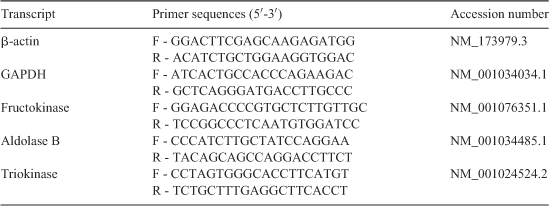62 EXPRESSION OF KEY ENZYMES OF THE FRUCTOSE METABOLIC PATHWAY IN NEWBORN IN VITRO-DERIVED CALVES
L. F. Schütz A B , K. C. S. Tavares A , F. C. Zago B , F. Forell B , V. H. V. Rodrigues A , L. H. Aguiar A B , P. C. Santos Neto B , J. MachadoA University of Fortaleza (UNIFOR), Fortaleza, CE, Brazil;
B Santa Catarina State University (UDESC), Lages, SC, Brazil;
C Ceará State University (UECE), Fortaleza, CE, Brazil
Reproduction, Fertility and Development 24(1) 143-143 https://doi.org/10.1071/RDv24n1Ab62
Published: 6 December 2011
Abstract
Newborn calves derived from IVF often have difficulties in adapting to life ex utero. Among physiological deviations, plasma fructose levels have been shown to be higher in in vitro-produced calves than in controls during the immediate neonatal period. Interestingly, as plasma fructose levels decrease, plasma lactate levels increase in the first hours of life, which may indicate a biochemical relationship between these substrates (Bertolini et al. 2004 Reproduction 128, 341–354). Fructokinase, the primary enzyme in the fructose metabolic pathway, bypasses the regulatory step catalyzed by phosphofructokinase, allowing fructose to undergo more rapid glycolysis in the liver than does glucose. However, information about the fructose metabolic pathway and fructokinase activity in the liver of neonates is lacking. This study was designed to verify the presence of gene transcripts for the 3 enzymes of the fructose pathway (fructokinase, aldolase B and triokinase) and the relative abundance of transcripts for fructokinase and glyceraldehyde-3-phosphate dehydrogenase (GAPDH), the enzyme that links the fructose metabolic pathway with glycolysis, in the liver of in vivo- or in vitro-produced newborn calves within the first hour of life. In vivo- or in vitro-produced newborn Flemish calves derived either by superovulation (n = 5) or by IVF (n = 4), respectively, were subject to liver biopsy procedures within the first hour after birth. Tissue samples were placed in cryotubes containing RNAlater™ (Qiagen Inc., Valencia, CA, USA). The RNA was extracted using Trizol® reagent (Invitrogen Corp., Carlsbad, CA, USA) and 300 ng of total RNA from each sample was used for cDNA synthesis with the SuperScript® III First-Strand Synthesis System (Invitrogen Corp.). Each PCR reaction used 5 μM of each specific primer to bovine fructokinase, aldolase B, triokinase and GAPDH (Table 1), 700 ng of cDNA and the PCR Master Mix (Quatro G Ltd., São Paulo, Brazil). For the quantitative PCR (qPCR), the Power SYBR Green PCR Master Mix (Applied Biosystems, Foster City, CA, USA) was used in the iQ5 Multicolor Real-Time PCR Detection System (Bio-Rad Laboratories, Hercules, CA, USA). Data for gene expression were normalized with the β-actin housekeeping gene, with the statistical analysis done by t-test (statistical analysis system). The PCR results indicated high fructokinase, aldolase B and triokinase expression levels in the liver of all newborn calves, irrespective of the group. Our preliminary qPCR data showed no differences in the hepatic expression levels for fructokinase (0.319 ± 0.136 vs 0.320 ± 0.179) and GAPDH (0.421 ± 0.243 vs 0.212 ± 0.147) between in vivo- and in vitro-produced calves, respectively. These data suggest that the fructose metabolic pathway is active in in vivo- and in vitro-produced newborn calves in the first hours of life. Consequently, excessive plasma fructose concentrations, as seen in some in vitro-produced calves, may affect carbohydrate metabolism, the acid-base balance and even survival during the neonatal period.

|
Funded by the RECODISA Project, FINEP/MCT/Brazil.


